In the 1990s, British automotive journalist Mark Walton drove a Dodge Viper pulling a travel trailer to 126.7 mph to establish a modern World Record speed. In 2002, a highly modified escort rally car bumped the record to 128.8 mph. In 2003, the record took a big jump. The combination of a 2-mile-long South African runway, a 700hp twin-turbo Mercedes, and an aerodynamic caravan boosted the record to 139.11 mph.
The record has stood at 139.11 mph since then, but not for a lack of trying. The British-based TV show Top Gear tried to break the record (then at 128.8 mph) with a modified Mitsubishi EVO, only to run 125 mph before blowing up the engine. More recently, an unnamed European company attempted to break the 139-mph record with a Porsche Cayenne S Turbo, only to have its aerodynamic trailer come off the ground at speed! In the last few decades, the record had moved around from Australia to Britain to South Africa, so it’s clearly an international record -- and not an easy one to break!
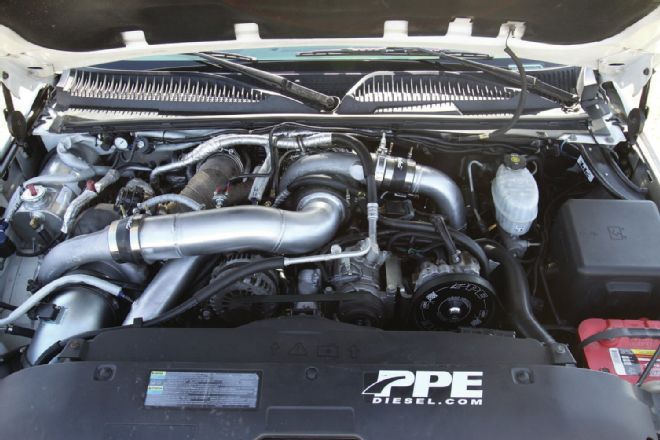
| The engine that powered this ’06 GMC to the record was built by Pacific Performance Engineering (PPE) and featured a number of mild and wild parts. Things like coated pistons, billet main caps, and a performance cam were skipped, but the engine did receive connecting rods, PPE’s pistons, ported heads, Dual Fuelers, and PPE’s Race Twin turbo kit, featuring 75mm and 106mm Garrett ball-bearing turbochargers. Horsepower checks in at 1,004 rwhp on fuel and an estimated 1,300 rwhp with nitrous.
The Plan
We needed a plan if we were going to tow faster than anyone else on the planet -- and some crazy friends to help us along the way. We found those partners in Pacific Performance Engineering (PPE) and Carson Trailer, which builds a wide range of campers, car trailers, and toy haulers. For our haul truck, PPE would be bringing their famous diesel drag truck dubbed “The Sleepermax” out of retirement. The truck already had 744 rear wheel horsepower (rwhp), but for record-breaking speeds, additional horsepower had to be on the table. To that end, the truck’s large twin turbos were swapped out for an even larger pair. A set of Exergy Engineering injectors provided 100-percent more fuel capability than stock, while a Nitrous Express (NX) dual-stage nitrous system was on hand in case we needed the extra horsepower.
For the trailer, we were understandably worried about aerodynamic stability, sway, and the trailer otherwise getting loose on us. To complicate matters further, we couldn’t use any type of sway control for the record attempt. In an effort to remain aerodynamically neutral (no lift or downforce), we chose Carson Trailer’s Kalispell. It was light, used a single axle (less rolling resistance), and was of 140-mph build quality. The Carson trailer was a perfect embodiment of a record-setting trailer in that it was compact (only 7½ feet wide and 10½ feet long), but it retained full amenities, including a bed, full-size refrigerator, and kitchen appliances -- all for about $10,000.
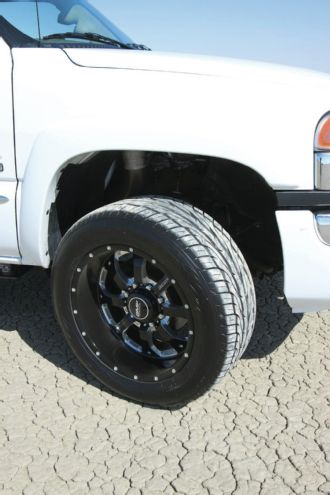
| Wheels and tires were of utmost importance for this project, so we were very careful when it came to picking them. Four 305/50R20 Toyo Proxes ST tires were mounted on 20x10-inch BMF Novakane wheels finished in Death Metal Black. The larger-diameter wheel enabled us to pick tires that were load-rated to 3,086 pounds each, yet still had a speed rating of 149 mph.
Choosing Tires
Our greatest fear during this attempt was crashing at 100-plus mph, so we spent a whole lot of time researching where the rubber meets the road. After speaking with many different manufacturers -- some of which simply said, “No way!” -- we finally settled on a set of 305/50R20 Toyo Proxes ST IIs mounted on 20x10 BMF wheels for the truck. The Toyos are rated at 149 mph, so we knew we’d be safe.
The trailer tires also had to be specially ordered. Traditional trailer tires are built for strength rather than speed and are actually only rated for 65 mph. For the trailer, we selected tires originally meant for a heavyweight sports sedan -- a set of Goodyear Gatorbacks. They were rated for the speed we wanted to go, and each could support 1,477 pounds of weight.
Doing the Math
With the truck and trailer prepped, we had to make sure we could actually break the existing record, and that’s where a fair amount of math came in. While we could have lowered the truck, put on racing tires, and made numerous aerodynamic modifications to make it look like a pure race vehicle, we decided to see if we could break the existing record driving just as one would normally drive down the road. After all, as former Diesel Power Editor David Kennedy said: “Race vehicles look like a race car driver could drive them…a normal vehicle looks like anyone could drive it.”
So if we were going to eschew the aerodynamic modifications, we needed a way to figure out how much power we’d need to move our brick towing a brick through the air. For this, an online calculator (www.rbracing-rsr.com/aerohpcalc.html) proved very helpful. The calculations said we’d need more than 1,000 rwhp to go 140 mph, based on a drag coefficient of .60 (which is bad) and a frontal area of 75 square feet (which is even worse). As it turned out, RBR’s calculator was almost dead-on.
Testing for the Record
Testing for the record was one of the hardest parts of the whole ordeal. The dragstrips wanted no part of us, and even a retired airstrip didn’t want us on their runway. “You need 3,000 hp to do it, plus, you’ll crash through our fence and die,” was their general opinion.
What we knew we could do, though, was to test the truck and trailer independently, so that’s what we did. To test the truck, we ran some 12-second passes at Fontana Speedway and also made some dyno pulls. After a few pulls and some tuning changes, we yielded a wild, 1,004 rwhp -- without nitrous!
As for the trailer, we mostly tested it behind our ’95 Dodge Ram, known as Project Triple Threat. We found we could hit 100 mph pretty easy, and the trailer remained stable -- even after emergency freeway lane changes. In talking with Carson Trailer’s David Endres, we were told in this situation the optimal hitch location was a few degrees below level, and our trailer tongue weight should be about 15 percent of the 2,700-pound total.
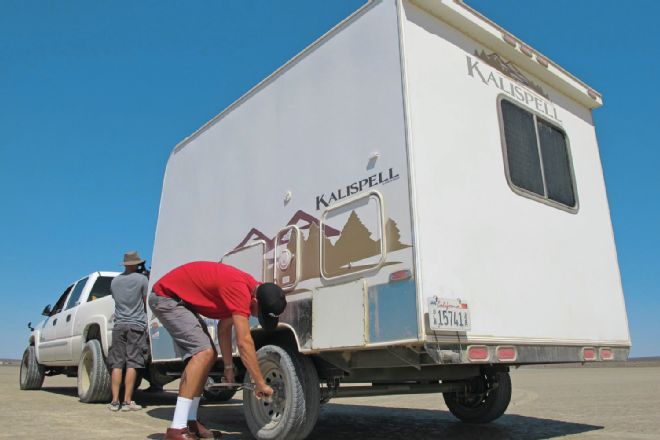
| Before our first test pass, a last-minute check was made to ensure all the lug nuts were tight on both the truck and trailer, and the tires were all at maximum pressure (50 psi).
Finding a Venue
After months of building, testing, and math, we still had to find a place for the attempt. The existing 139.11-mph record had been set on a 2-mile-long South African runway. Since the Diesel Power magazine effort had a lot more horsepower, but also a lot more aerodynamic drag, we felt it would take about 1-1/2 miles to reach our top speed, with another 1/2 mile to stop. We set our sights on an arrow-straight road of 2 miles or more, which is actually pretty hard to find here in the Los Angeles area. Initially, we planned on running out at El Toro airfield, but they said they lacked the room. The El Mirage dry lakebed got dismissed because of drag and traction, and a 3-mile-long road up in Lancaster, California, was out because of the cost of shutting down a public road. So we arrived at the Mojave Air and Space port, a 2-mile runway located in the desert north of Los Angeles.
As it turns out, our luck was doubly good, as MKM Racing Promotions was holding its annual Mojave Mile, a standing 1-mile event that measures a vehicle’s exit speed. The event coordinator, Mike Borders, was surprisingly receptive to our crazy idea and agreed we could at the very least make a few 120-mph test passes there. Then tragedy struck. At a private event before the Mojave Mile, an older gentleman had a heart attack and died at the wheel of his Ford GT, leaving the car to spin off track at more than 200 mph. The airport was understandably concerned and told Mike they would be enforcing the rules with an iron fist. “Well, there are a few journalists who want to try to go more than 120 mph while towing a trailer,” he admitted, and that was it. The day before our scheduled run, we were sunk.
After a few months of stagnation and careful consideration, we knew the next best answer had to be El Mirage dry lake bed. It wasn’t perfect, being that it was a dirt surface, but it had the space we required and was affordable. It was then everything came into focus, and we knew our attempt was to be made at El Mirage.
Final Testing
Before our official run, David from Carson Trailer and Corey Macha from PPE met up with us at El Mirage to do some testing. We unhooked everything and went 104 mph on a test pass. Then we hit 125 mph with the truck and trailer -- matching Top Gear’s attempt -- while keeping EGT less than 1,600 degrees, and without using nitrous. Our official run needed us to go 15 mph faster, and we knew those last 15 mph were going to be tough.
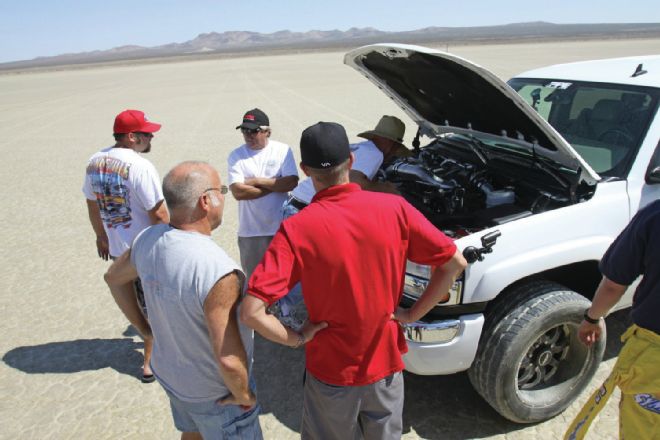
| We noticed some oil on the ground, and with 2,000 degree EGT, we were very concerned we had blown something up. As it turns out, the Garrett ball-bearing turbos, as well as the rest of the engine, were still just fine.
The Record Run: Break it, or Bust the Truck Trying
It all came down to one day. We’d hired a timing official to set up timing lights at El Mirage. We had the truck, trailer, and a crew of about 30 people giving support and help in any way they could -- from photography to changing nitrous bottles. Associate Editor Jason Sands explained the day of the attempt from the driver seat:
“A lot of people were asking me if I was nervous before the run, and I was, a little, but I got through most of the jitters the night before. At that moment, I was just aware of what it was I had to do. I knew I needed to manually shift the truck, hit both stages of nitrous, and keep an eye on the EGT gauge -- all while keeping the truck between the cones. I had practiced on dirt before, so I knew the truck and trailer were going to wander a little at high speed. The wandering isn’t so much of a sway, but more of a quick darting motion from side to side. Overcorrect, and I could cause a spin. Undercorrect, and the truck would make its way off course. Steering motions are made in quick flicks of the wrist rather than big, sweeping gestures.
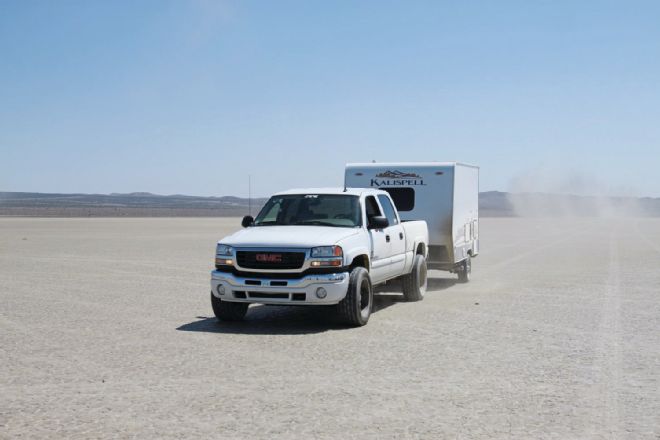
| Success! We’d blasted by the record. We brought the truck and trailer back around to our timing area for inspection.
With all of this in my head, I strapped in, put my fire jacket on, took a deep breath, and lowered the visor of my helmet. The timing official signaled that the course was clear, and I was off. The first run was mostly a test of the course, and I found that a little past a quarter-mile in was a pretty big bump that upset the truck and trailer. I lifted to about half-throttle (lifting all the way would’ve upset the vehicle even more) and then rolled back in it. I kept EGT at about 1,600, and then powered through the traps without activating the nitrous. It was pulling, but not much, and when the timer yelled out ‘120 mph!’ I felt a sinking feeling. I wasn’t sure if we would have enough to beat the record, even with the 10-percent extra fuel that Joe Komaromi from PPE had put in the tune the night before.
“There was nothing to do now but crack the bottle and see how far two 0.080 jets of nitrous could push us. This time, I waited until after the bump to nail it, but as the truck accelerated, the steering corrections I had to make multiplied, and by the last half mile of the course, I didn’t feel it was safe to take my hand off the wheel to grab the second stage of nitrous. I was movin’ as I went through the traps, but in the desert speed is hard to judge. If you would have told me I was going 130 mph or 150 mph, I would have believed either. I took a quick glance at the EGT gauge as I headed toward the last quarter mile and saw it was buried at 2,000 degrees. All I could think about was not crashing and mentally preparing for the engine to let go. Surprisingly, neither one happened, and the truck blistered through the traps at full power. As I came back to the timing tower, the crowd was giving me the thumbs-up. ‘You beat it!’ they yelled. The official speed was 139.33 mph. I had eked past the record by a mere .2 mph.
“I left the truck running so it could gradually cool down and talked to the PPE crew about the attempt. I told them I had seen 2,000 degrees on the pyrometer and asked if they wanted me to make another run. Joe Komaromi shrugged and simply said, ‘If we’re going to blow it up, now’s the time. We still have the second stage left.’ That sounded like a yes to me, so I suited up for the next pass.
“On the third run, I waited even longer to make everything happen. I turned on the first stage of nitrous, shifted into Sixth Gear, grabbed the button for the second stage, and held the truck and trailer at about 110 to 115 mph. I waited for a full 15 seconds before nailing it and hitting the button for the second stage and powering through the traps for the last half mile. I could hear the engine working hard and was pushed back in the seat as the second stage hit. I felt the truck hit an aerodynamic wall rather quickly, but it just felt faster than the previous run. As I returned to the pits, everyone was cheering again. We’d broken the 140-mph barrier -- and beaten the record by a full 3 mph, to the tune of 141.99 mph.
“After the champagne celebration, you might be thinking we loaded everything up and went home, but that actually wasn’t the case. We took the PPE Duramax, loaded in the freeway-friendly tune, and went out to dinner: truck, trailer, and all the hardware. As we pulled into the parking lot of a burger joint and ordered our food, we looked back out at the dusty truck and trailer in the parking lot. It was then that it hit us, we had just gone faster than anyone else on earth with a trailer a few hours ago and were now taking the same four-door truck out to dinner. And it doesn’t get any cooler than that.”
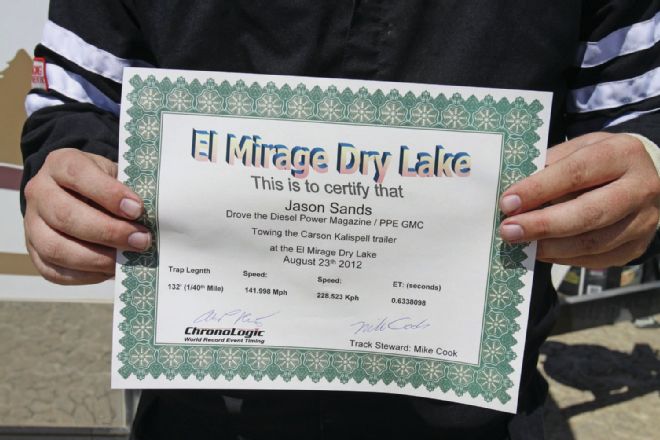
| Since we were shooting for an official record, we had timers from the Southern California Timing Association come out and measure our exact speed, down to the third decimal place. We also had GPS on board, which backed up the official time with a 142-mph reading.
140-mph Towing: How it Applies to You
When we first introduced the idea of high-speed towing months and months ago, we got a whole flood of letters supporting our attempt, but we also got a surprising amount of backlash. “I have no idea why you’re doing this, I just want better fuel economy,” one reader wrote. Another indicated he didn’t think anything we did would apply to him.
As it turns out, virtually everything we did to break this world record can be thought of in normal, over-the-road terms. Aerodynamic load and drag holds a direct correlation to fuel economy. Building an efficient engine is another key to both towing with power and fuel efficiency. While our EGT limit was sufficiently higher than we’d ever recommend to anyone, there are similarities there, too. While you might not tow with nitrous, well-matched turbos (especially compounds) are very important to towing combinations. Load and speed rating of tires are a direct crossover, as is trailer tongue weight.
We didn’t just do this stuff because we could -- we did it for all you readers, too. You might not want to tow at 140 mph, but everything it took to get the truck and trailer there can be directly applied to a normal, 55-mph towing effort.
Kalispell by Carson Trailer Specifications
Price: $10,000
Size: 7 feet 6 inches x 10 feet 6 inches x 10 feet
Weight (dry): 2,670 pounds
Max weight (loaded): 5,200 pounds
Features: Fullsize LP/DC/110V refrigerator
6-gallon water heater
Insulated walls and ceiling
Single RV/marine battery
18,000 B.T.U. furnace
60-amp converter with 12-volt battery charger
Heavy-duty axle with electric brakes
2006 GMC 2500 Specifications
Price: $80,000 (est.)
Owner/Hometown: Joe Komaromi; Fullerton, California
Engine: 6.6-L Duramax diesel; ARP head and main studs, ported heads, Carrillo rods, and PPE pistons
Air: PPE compound turbos; Garrett GT4202 and GT5533
Fuel: PPE dual fuelers and 100-percent-over injectors
Programmer: PPE Hot+2 E.T. Race and EFILive
Transmission: Prototype PPE Stage 6
Suspension: Cognito steering braces and tie-rod sleeves
Wheels and Tires: 20x10 BMF Novokane, 305/50R20 Toyo Proxes ST II
Performance (calculated without trailer)
0 to 60 mph: 2.5 seconds
Quarter-mile Time and Speed: 10.8 seconds at 136 mph
Top Speed: 206 mph
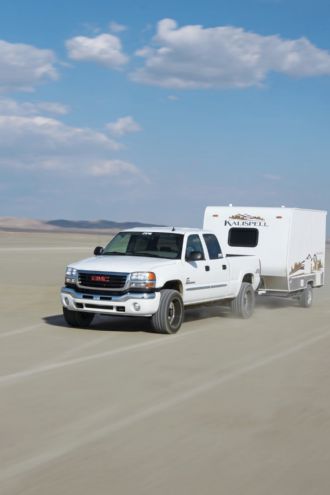
| PPE 2006 GMC Sierra Record Breaking Trailer Haul Front View In Motion
 | The engine that powered this ’06 GMC to the record was built by Pacific Performance Engineering (PPE) and featured a number of mild and wild parts. Things like coated pistons, billet main caps, and a performance cam were skipped, but the engine did receive connecting rods, PPE’s pistons, ported heads, Dual Fuelers, and PPE’s Race Twin turbo kit, featuring 75mm and 106mm Garrett ball-bearing turbochargers. Horsepower checks in at 1,004 rwhp on fuel and an estimated 1,300 rwhp with nitrous.
The Plan
We needed a plan if we were going to tow faster than anyone else on the planet -- and some crazy friends to help us along the way. We found those partners in Pacific Performance Engineering (PPE) and Carson Trailer, which builds a wide range of campers, car trailers, and toy haulers. For our haul truck, PPE would be bringing their famous diesel drag truck dubbed “The Sleepermax” out of retirement. The truck already had 744 rear wheel horsepower (rwhp), but for record-breaking speeds, additional horsepower had to be on the table. To that end, the truck’s large twin turbos were swapped out for an even larger pair. A set of Exergy Engineering injectors provided 100-percent more fuel capability than stock, while a Nitrous Express (NX) dual-stage nitrous system was on hand in case we needed the extra horsepower.
For the trailer, we were understandably worried about aerodynamic stability, sway, and the trailer otherwise getting loose on us. To complicate matters further, we couldn’t use any type of sway control for the record attempt. In an effort to remain aerodynamically neutral (no lift or downforce), we chose Carson Trailer’s Kalispell. It was light, used a single axle (less rolling resistance), and was of 140-mph build quality. The Carson trailer was a perfect embodiment of a record-setting trailer in that it was compact (only 7½ feet wide and 10½ feet long), but it retained full amenities, including a bed, full-size refrigerator, and kitchen appliances -- all for about $10,000.
| The engine that powered this ’06 GMC to the record was built by Pacific Performance Engineering (PPE) and featured a number of mild and wild parts. Things like coated pistons, billet main caps, and a performance cam were skipped, but the engine did receive connecting rods, PPE’s pistons, ported heads, Dual Fuelers, and PPE’s Race Twin turbo kit, featuring 75mm and 106mm Garrett ball-bearing turbochargers. Horsepower checks in at 1,004 rwhp on fuel and an estimated 1,300 rwhp with nitrous.
The Plan
We needed a plan if we were going to tow faster than anyone else on the planet -- and some crazy friends to help us along the way. We found those partners in Pacific Performance Engineering (PPE) and Carson Trailer, which builds a wide range of campers, car trailers, and toy haulers. For our haul truck, PPE would be bringing their famous diesel drag truck dubbed “The Sleepermax” out of retirement. The truck already had 744 rear wheel horsepower (rwhp), but for record-breaking speeds, additional horsepower had to be on the table. To that end, the truck’s large twin turbos were swapped out for an even larger pair. A set of Exergy Engineering injectors provided 100-percent more fuel capability than stock, while a Nitrous Express (NX) dual-stage nitrous system was on hand in case we needed the extra horsepower.
For the trailer, we were understandably worried about aerodynamic stability, sway, and the trailer otherwise getting loose on us. To complicate matters further, we couldn’t use any type of sway control for the record attempt. In an effort to remain aerodynamically neutral (no lift or downforce), we chose Carson Trailer’s Kalispell. It was light, used a single axle (less rolling resistance), and was of 140-mph build quality. The Carson trailer was a perfect embodiment of a record-setting trailer in that it was compact (only 7½ feet wide and 10½ feet long), but it retained full amenities, including a bed, full-size refrigerator, and kitchen appliances -- all for about $10,000.
 | Wheels and tires were of utmost importance for this project, so we were very careful when it came to picking them. Four 305/50R20 Toyo Proxes ST tires were mounted on 20x10-inch BMF Novakane wheels finished in Death Metal Black. The larger-diameter wheel enabled us to pick tires that were load-rated to 3,086 pounds each, yet still had a speed rating of 149 mph.
Choosing Tires
Our greatest fear during this attempt was crashing at 100-plus mph, so we spent a whole lot of time researching where the rubber meets the road. After speaking with many different manufacturers -- some of which simply said, “No way!” -- we finally settled on a set of 305/50R20 Toyo Proxes ST IIs mounted on 20x10 BMF wheels for the truck. The Toyos are rated at 149 mph, so we knew we’d be safe.
The trailer tires also had to be specially ordered. Traditional trailer tires are built for strength rather than speed and are actually only rated for 65 mph. For the trailer, we selected tires originally meant for a heavyweight sports sedan -- a set of Goodyear Gatorbacks. They were rated for the speed we wanted to go, and each could support 1,477 pounds of weight.
Doing the Math
With the truck and trailer prepped, we had to make sure we could actually break the existing record, and that’s where a fair amount of math came in. While we could have lowered the truck, put on racing tires, and made numerous aerodynamic modifications to make it look like a pure race vehicle, we decided to see if we could break the existing record driving just as one would normally drive down the road. After all, as former Diesel Power Editor David Kennedy said: “Race vehicles look like a race car driver could drive them…a normal vehicle looks like anyone could drive it.”
So if we were going to eschew the aerodynamic modifications, we needed a way to figure out how much power we’d need to move our brick towing a brick through the air. For this, an online calculator (www.rbracing-rsr.com/aerohpcalc.html) proved very helpful. The calculations said we’d need more than 1,000 rwhp to go 140 mph, based on a drag coefficient of .60 (which is bad) and a frontal area of 75 square feet (which is even worse). As it turned out, RBR’s calculator was almost dead-on.
| Wheels and tires were of utmost importance for this project, so we were very careful when it came to picking them. Four 305/50R20 Toyo Proxes ST tires were mounted on 20x10-inch BMF Novakane wheels finished in Death Metal Black. The larger-diameter wheel enabled us to pick tires that were load-rated to 3,086 pounds each, yet still had a speed rating of 149 mph.
Choosing Tires
Our greatest fear during this attempt was crashing at 100-plus mph, so we spent a whole lot of time researching where the rubber meets the road. After speaking with many different manufacturers -- some of which simply said, “No way!” -- we finally settled on a set of 305/50R20 Toyo Proxes ST IIs mounted on 20x10 BMF wheels for the truck. The Toyos are rated at 149 mph, so we knew we’d be safe.
The trailer tires also had to be specially ordered. Traditional trailer tires are built for strength rather than speed and are actually only rated for 65 mph. For the trailer, we selected tires originally meant for a heavyweight sports sedan -- a set of Goodyear Gatorbacks. They were rated for the speed we wanted to go, and each could support 1,477 pounds of weight.
Doing the Math
With the truck and trailer prepped, we had to make sure we could actually break the existing record, and that’s where a fair amount of math came in. While we could have lowered the truck, put on racing tires, and made numerous aerodynamic modifications to make it look like a pure race vehicle, we decided to see if we could break the existing record driving just as one would normally drive down the road. After all, as former Diesel Power Editor David Kennedy said: “Race vehicles look like a race car driver could drive them…a normal vehicle looks like anyone could drive it.”
So if we were going to eschew the aerodynamic modifications, we needed a way to figure out how much power we’d need to move our brick towing a brick through the air. For this, an online calculator (www.rbracing-rsr.com/aerohpcalc.html) proved very helpful. The calculations said we’d need more than 1,000 rwhp to go 140 mph, based on a drag coefficient of .60 (which is bad) and a frontal area of 75 square feet (which is even worse). As it turned out, RBR’s calculator was almost dead-on.
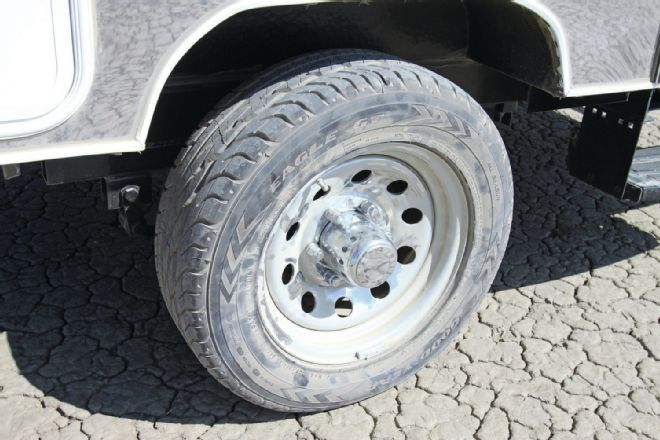
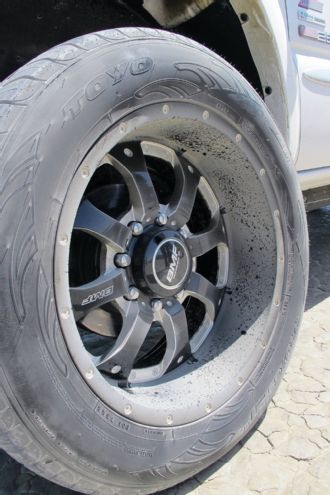
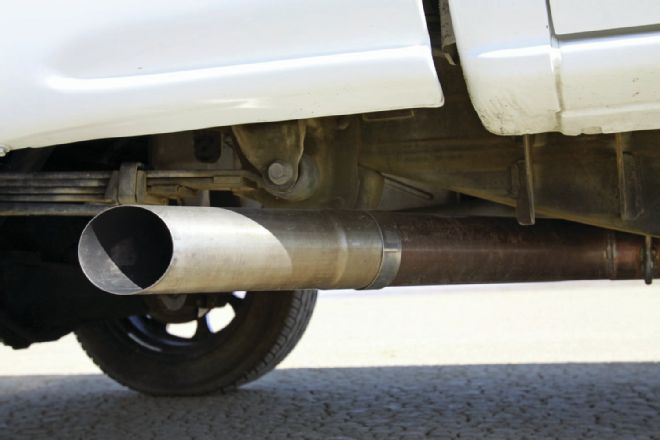
 | Before our first test pass, a last-minute check was made to ensure all the lug nuts were tight on both the truck and trailer, and the tires were all at maximum pressure (50 psi).
Finding a Venue
After months of building, testing, and math, we still had to find a place for the attempt. The existing 139.11-mph record had been set on a 2-mile-long South African runway. Since the Diesel Power magazine effort had a lot more horsepower, but also a lot more aerodynamic drag, we felt it would take about 1-1/2 miles to reach our top speed, with another 1/2 mile to stop. We set our sights on an arrow-straight road of 2 miles or more, which is actually pretty hard to find here in the Los Angeles area. Initially, we planned on running out at El Toro airfield, but they said they lacked the room. The El Mirage dry lakebed got dismissed because of drag and traction, and a 3-mile-long road up in Lancaster, California, was out because of the cost of shutting down a public road. So we arrived at the Mojave Air and Space port, a 2-mile runway located in the desert north of Los Angeles.
As it turns out, our luck was doubly good, as MKM Racing Promotions was holding its annual Mojave Mile, a standing 1-mile event that measures a vehicle’s exit speed. The event coordinator, Mike Borders, was surprisingly receptive to our crazy idea and agreed we could at the very least make a few 120-mph test passes there. Then tragedy struck. At a private event before the Mojave Mile, an older gentleman had a heart attack and died at the wheel of his Ford GT, leaving the car to spin off track at more than 200 mph. The airport was understandably concerned and told Mike they would be enforcing the rules with an iron fist. “Well, there are a few journalists who want to try to go more than 120 mph while towing a trailer,” he admitted, and that was it. The day before our scheduled run, we were sunk.
After a few months of stagnation and careful consideration, we knew the next best answer had to be El Mirage dry lake bed. It wasn’t perfect, being that it was a dirt surface, but it had the space we required and was affordable. It was then everything came into focus, and we knew our attempt was to be made at El Mirage.
Final Testing
Before our official run, David from Carson Trailer and Corey Macha from PPE met up with us at El Mirage to do some testing. We unhooked everything and went 104 mph on a test pass. Then we hit 125 mph with the truck and trailer -- matching Top Gear’s attempt -- while keeping EGT less than 1,600 degrees, and without using nitrous. Our official run needed us to go 15 mph faster, and we knew those last 15 mph were going to be tough.
| Before our first test pass, a last-minute check was made to ensure all the lug nuts were tight on both the truck and trailer, and the tires were all at maximum pressure (50 psi).
Finding a Venue
After months of building, testing, and math, we still had to find a place for the attempt. The existing 139.11-mph record had been set on a 2-mile-long South African runway. Since the Diesel Power magazine effort had a lot more horsepower, but also a lot more aerodynamic drag, we felt it would take about 1-1/2 miles to reach our top speed, with another 1/2 mile to stop. We set our sights on an arrow-straight road of 2 miles or more, which is actually pretty hard to find here in the Los Angeles area. Initially, we planned on running out at El Toro airfield, but they said they lacked the room. The El Mirage dry lakebed got dismissed because of drag and traction, and a 3-mile-long road up in Lancaster, California, was out because of the cost of shutting down a public road. So we arrived at the Mojave Air and Space port, a 2-mile runway located in the desert north of Los Angeles.
As it turns out, our luck was doubly good, as MKM Racing Promotions was holding its annual Mojave Mile, a standing 1-mile event that measures a vehicle’s exit speed. The event coordinator, Mike Borders, was surprisingly receptive to our crazy idea and agreed we could at the very least make a few 120-mph test passes there. Then tragedy struck. At a private event before the Mojave Mile, an older gentleman had a heart attack and died at the wheel of his Ford GT, leaving the car to spin off track at more than 200 mph. The airport was understandably concerned and told Mike they would be enforcing the rules with an iron fist. “Well, there are a few journalists who want to try to go more than 120 mph while towing a trailer,” he admitted, and that was it. The day before our scheduled run, we were sunk.
After a few months of stagnation and careful consideration, we knew the next best answer had to be El Mirage dry lake bed. It wasn’t perfect, being that it was a dirt surface, but it had the space we required and was affordable. It was then everything came into focus, and we knew our attempt was to be made at El Mirage.
Final Testing
Before our official run, David from Carson Trailer and Corey Macha from PPE met up with us at El Mirage to do some testing. We unhooked everything and went 104 mph on a test pass. Then we hit 125 mph with the truck and trailer -- matching Top Gear’s attempt -- while keeping EGT less than 1,600 degrees, and without using nitrous. Our official run needed us to go 15 mph faster, and we knew those last 15 mph were going to be tough.
 | We noticed some oil on the ground, and with 2,000 degree EGT, we were very concerned we had blown something up. As it turns out, the Garrett ball-bearing turbos, as well as the rest of the engine, were still just fine.
| We noticed some oil on the ground, and with 2,000 degree EGT, we were very concerned we had blown something up. As it turns out, the Garrett ball-bearing turbos, as well as the rest of the engine, were still just fine.
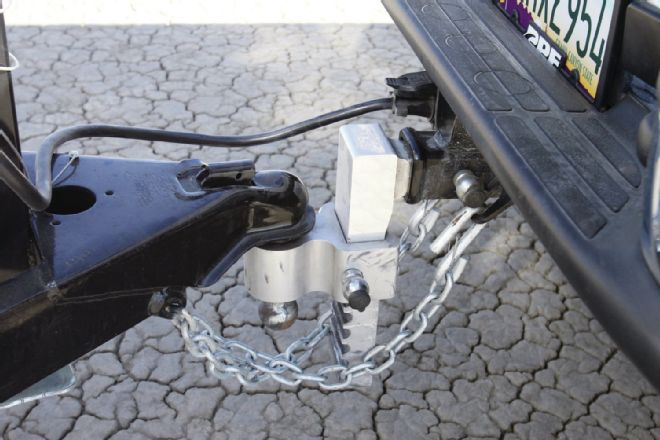
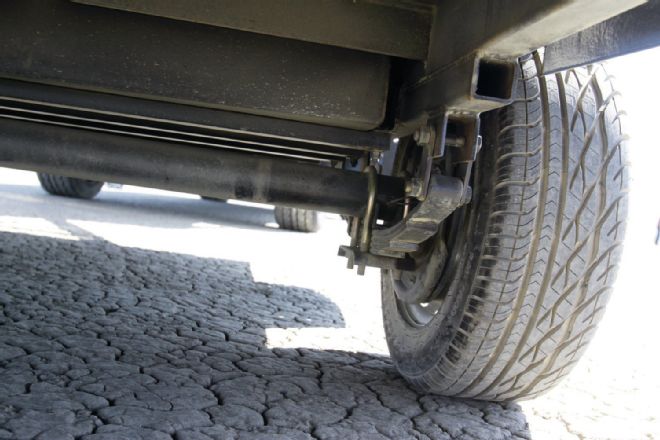
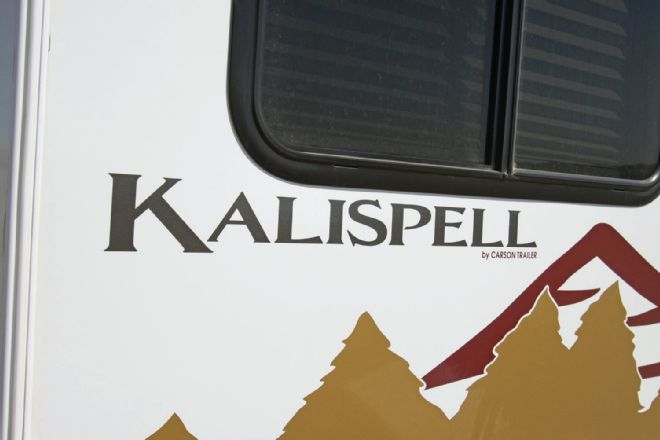
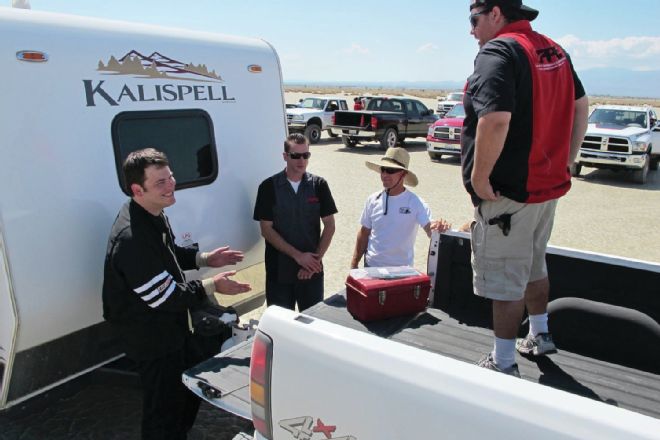
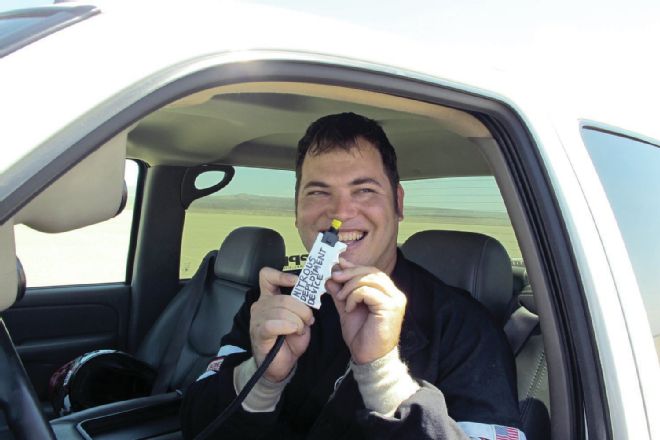
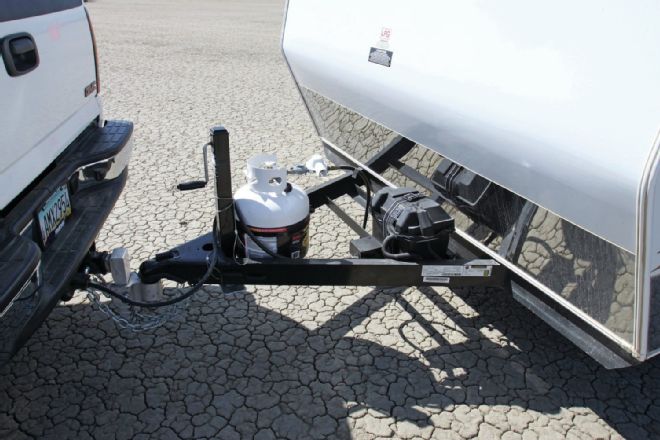
 | Success! We’d blasted by the record. We brought the truck and trailer back around to our timing area for inspection.
With all of this in my head, I strapped in, put my fire jacket on, took a deep breath, and lowered the visor of my helmet. The timing official signaled that the course was clear, and I was off. The first run was mostly a test of the course, and I found that a little past a quarter-mile in was a pretty big bump that upset the truck and trailer. I lifted to about half-throttle (lifting all the way would’ve upset the vehicle even more) and then rolled back in it. I kept EGT at about 1,600, and then powered through the traps without activating the nitrous. It was pulling, but not much, and when the timer yelled out ‘120 mph!’ I felt a sinking feeling. I wasn’t sure if we would have enough to beat the record, even with the 10-percent extra fuel that Joe Komaromi from PPE had put in the tune the night before.
“There was nothing to do now but crack the bottle and see how far two 0.080 jets of nitrous could push us. This time, I waited until after the bump to nail it, but as the truck accelerated, the steering corrections I had to make multiplied, and by the last half mile of the course, I didn’t feel it was safe to take my hand off the wheel to grab the second stage of nitrous. I was movin’ as I went through the traps, but in the desert speed is hard to judge. If you would have told me I was going 130 mph or 150 mph, I would have believed either. I took a quick glance at the EGT gauge as I headed toward the last quarter mile and saw it was buried at 2,000 degrees. All I could think about was not crashing and mentally preparing for the engine to let go. Surprisingly, neither one happened, and the truck blistered through the traps at full power. As I came back to the timing tower, the crowd was giving me the thumbs-up. ‘You beat it!’ they yelled. The official speed was 139.33 mph. I had eked past the record by a mere .2 mph.
“I left the truck running so it could gradually cool down and talked to the PPE crew about the attempt. I told them I had seen 2,000 degrees on the pyrometer and asked if they wanted me to make another run. Joe Komaromi shrugged and simply said, ‘If we’re going to blow it up, now’s the time. We still have the second stage left.’ That sounded like a yes to me, so I suited up for the next pass.
“On the third run, I waited even longer to make everything happen. I turned on the first stage of nitrous, shifted into Sixth Gear, grabbed the button for the second stage, and held the truck and trailer at about 110 to 115 mph. I waited for a full 15 seconds before nailing it and hitting the button for the second stage and powering through the traps for the last half mile. I could hear the engine working hard and was pushed back in the seat as the second stage hit. I felt the truck hit an aerodynamic wall rather quickly, but it just felt faster than the previous run. As I returned to the pits, everyone was cheering again. We’d broken the 140-mph barrier -- and beaten the record by a full 3 mph, to the tune of 141.99 mph.
“After the champagne celebration, you might be thinking we loaded everything up and went home, but that actually wasn’t the case. We took the PPE Duramax, loaded in the freeway-friendly tune, and went out to dinner: truck, trailer, and all the hardware. As we pulled into the parking lot of a burger joint and ordered our food, we looked back out at the dusty truck and trailer in the parking lot. It was then that it hit us, we had just gone faster than anyone else on earth with a trailer a few hours ago and were now taking the same four-door truck out to dinner. And it doesn’t get any cooler than that.”
| Success! We’d blasted by the record. We brought the truck and trailer back around to our timing area for inspection.
With all of this in my head, I strapped in, put my fire jacket on, took a deep breath, and lowered the visor of my helmet. The timing official signaled that the course was clear, and I was off. The first run was mostly a test of the course, and I found that a little past a quarter-mile in was a pretty big bump that upset the truck and trailer. I lifted to about half-throttle (lifting all the way would’ve upset the vehicle even more) and then rolled back in it. I kept EGT at about 1,600, and then powered through the traps without activating the nitrous. It was pulling, but not much, and when the timer yelled out ‘120 mph!’ I felt a sinking feeling. I wasn’t sure if we would have enough to beat the record, even with the 10-percent extra fuel that Joe Komaromi from PPE had put in the tune the night before.
“There was nothing to do now but crack the bottle and see how far two 0.080 jets of nitrous could push us. This time, I waited until after the bump to nail it, but as the truck accelerated, the steering corrections I had to make multiplied, and by the last half mile of the course, I didn’t feel it was safe to take my hand off the wheel to grab the second stage of nitrous. I was movin’ as I went through the traps, but in the desert speed is hard to judge. If you would have told me I was going 130 mph or 150 mph, I would have believed either. I took a quick glance at the EGT gauge as I headed toward the last quarter mile and saw it was buried at 2,000 degrees. All I could think about was not crashing and mentally preparing for the engine to let go. Surprisingly, neither one happened, and the truck blistered through the traps at full power. As I came back to the timing tower, the crowd was giving me the thumbs-up. ‘You beat it!’ they yelled. The official speed was 139.33 mph. I had eked past the record by a mere .2 mph.
“I left the truck running so it could gradually cool down and talked to the PPE crew about the attempt. I told them I had seen 2,000 degrees on the pyrometer and asked if they wanted me to make another run. Joe Komaromi shrugged and simply said, ‘If we’re going to blow it up, now’s the time. We still have the second stage left.’ That sounded like a yes to me, so I suited up for the next pass.
“On the third run, I waited even longer to make everything happen. I turned on the first stage of nitrous, shifted into Sixth Gear, grabbed the button for the second stage, and held the truck and trailer at about 110 to 115 mph. I waited for a full 15 seconds before nailing it and hitting the button for the second stage and powering through the traps for the last half mile. I could hear the engine working hard and was pushed back in the seat as the second stage hit. I felt the truck hit an aerodynamic wall rather quickly, but it just felt faster than the previous run. As I returned to the pits, everyone was cheering again. We’d broken the 140-mph barrier -- and beaten the record by a full 3 mph, to the tune of 141.99 mph.
“After the champagne celebration, you might be thinking we loaded everything up and went home, but that actually wasn’t the case. We took the PPE Duramax, loaded in the freeway-friendly tune, and went out to dinner: truck, trailer, and all the hardware. As we pulled into the parking lot of a burger joint and ordered our food, we looked back out at the dusty truck and trailer in the parking lot. It was then that it hit us, we had just gone faster than anyone else on earth with a trailer a few hours ago and were now taking the same four-door truck out to dinner. And it doesn’t get any cooler than that.”
 | Since we were shooting for an official record, we had timers from the Southern California Timing Association come out and measure our exact speed, down to the third decimal place. We also had GPS on board, which backed up the official time with a 142-mph reading.
140-mph Towing: How it Applies to You
When we first introduced the idea of high-speed towing months and months ago, we got a whole flood of letters supporting our attempt, but we also got a surprising amount of backlash. “I have no idea why you’re doing this, I just want better fuel economy,” one reader wrote. Another indicated he didn’t think anything we did would apply to him.
As it turns out, virtually everything we did to break this world record can be thought of in normal, over-the-road terms. Aerodynamic load and drag holds a direct correlation to fuel economy. Building an efficient engine is another key to both towing with power and fuel efficiency. While our EGT limit was sufficiently higher than we’d ever recommend to anyone, there are similarities there, too. While you might not tow with nitrous, well-matched turbos (especially compounds) are very important to towing combinations. Load and speed rating of tires are a direct crossover, as is trailer tongue weight.
We didn’t just do this stuff because we could -- we did it for all you readers, too. You might not want to tow at 140 mph, but everything it took to get the truck and trailer there can be directly applied to a normal, 55-mph towing effort.
| Since we were shooting for an official record, we had timers from the Southern California Timing Association come out and measure our exact speed, down to the third decimal place. We also had GPS on board, which backed up the official time with a 142-mph reading.
140-mph Towing: How it Applies to You
When we first introduced the idea of high-speed towing months and months ago, we got a whole flood of letters supporting our attempt, but we also got a surprising amount of backlash. “I have no idea why you’re doing this, I just want better fuel economy,” one reader wrote. Another indicated he didn’t think anything we did would apply to him.
As it turns out, virtually everything we did to break this world record can be thought of in normal, over-the-road terms. Aerodynamic load and drag holds a direct correlation to fuel economy. Building an efficient engine is another key to both towing with power and fuel efficiency. While our EGT limit was sufficiently higher than we’d ever recommend to anyone, there are similarities there, too. While you might not tow with nitrous, well-matched turbos (especially compounds) are very important to towing combinations. Load and speed rating of tires are a direct crossover, as is trailer tongue weight.
We didn’t just do this stuff because we could -- we did it for all you readers, too. You might not want to tow at 140 mph, but everything it took to get the truck and trailer there can be directly applied to a normal, 55-mph towing effort.
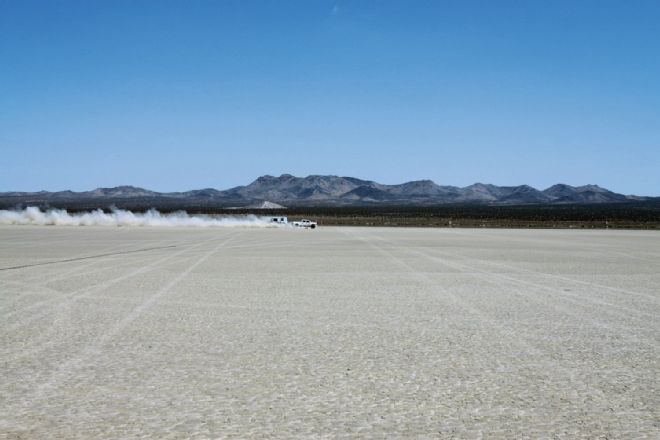
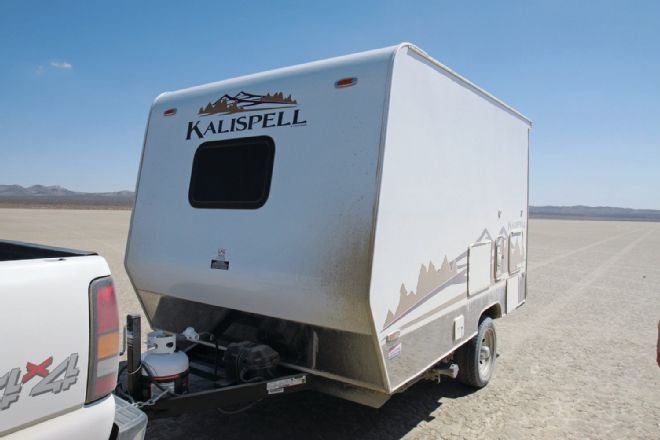
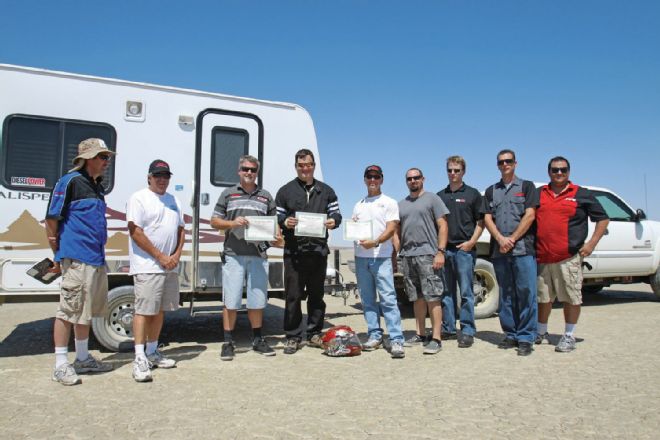
 | PPE 2006 GMC Sierra Record Breaking Trailer Haul Front View In Motion
| PPE 2006 GMC Sierra Record Breaking Trailer Haul Front View In Motion